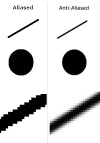Difference between revisions of "Dictionary"
| Line 17: | Line 17: | ||
===Banding=== | ===Banding=== | ||
[[File:Dictionary-banding.png|left|100px|thumb|alt=Banding]]Banding is considered a highly flawed technique, in which you shade by following the outline's shape. This should regularly be avoid, as it prevents an object from portraying depth and shape properly. This is generally considered to be a poor excuse for [[Dictionary#Anti-Aliasing|Anti-Aliasing]]. | [[File:Dictionary-banding.png|left|100px|thumb|alt=Banding]]Banding is considered a highly flawed technique, in which you shade by following the outline's shape. This should regularly be avoid, as it prevents an object from portraying depth and shape properly. This is generally considered to be a poor excuse for [[Dictionary#Anti-Aliasing|Anti-Aliasing]]. | ||
| + | |||
Revision as of 13:04, 20 May 2014
Contents
Spriting Dictionary
Anti-Aliasing
Anti-Aliasing, often refered to as simply "AA", is a technique in which you place mid-tone pixels in strategical places to make lines appear smoother.
In the case shown to the left, the black line is anti-aliased by gray pixels placed on the 'corners', because the background is white (white+black=gray). If the line was red, then the gray dots should be changed to light pink to portray correct anti-aliasing.
Keep in mind that the image example was generated with Photoshop, thus creating a a lot of mid-tone pixels for aliasing. In spriting you would generally use far less aliasing, and place them in a more organised manner. They should only be placed in jagged places; if the line is already smooth without AA, there's no particular need to do it.
Banding
Banding is considered a highly flawed technique, in which you shade by following the outline's shape. This should regularly be avoid, as it prevents an object from portraying depth and shape properly. This is generally considered to be a poor excuse for Anti-Aliasing.


